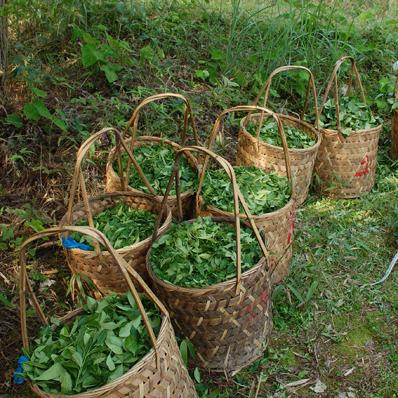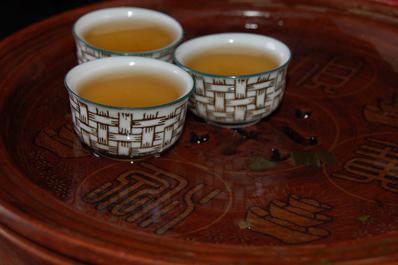Oolong tea is a semi-fermented variety of Chinese tea that combines the best properties of green (non-oxidized) and black (oxidized) teas - light and aromatic, refreshing and strong. A typical oxidation level of oolong is from about ten to seventy percent. In general, it is believed that this is the most complex type of tea. Its processing includes five main stages: drying in the sun and fermentation; drying at a temperature of at least 250 degrees; twisting; drying at a temperature of about 100 degrees to stop the oxidation process; sorting and classification.

Oolong tea is produced in several areas and sorted into four types, depending on the place of origin (Northern Fujian, Southern Fujian, Guangdong and Taiwan). What is interesting - its name (translated as "black dragon") remains to some extent a mystery in the history of Chinese teas. A lot of legendary stories are connected with it. One of them says that this was the name of the person who first invented the method of producing an aromatic drink - Su Long. Once, having gathered for himself a bundle of tea leaves, a man returned home and saw a deer along the way. Without hesitation, he went hunting for the beast, which turned out to be successful for him. The next day, the man was so absorbed in this joyful event that he completely forgot about tea leaves. When he opened the bundle in the evening, he found that the leaves had changed color and turned almost brown. Fearing to lose the harvest, he quickly brewed tea and was struck by its unique taste and aroma. Su Lun treated friends and neighbors with tea and shared a recipe with them. The fame of the wonderful drink spread very quickly, and it eventually became known as oolong tea.
Although, most likely, the association with the black dragon arose due to the type of leaves when brewing. They acquire volume and curvature, become almost blue-black, resembling a mythological Chinese water dragon.
The origins of this tea date back to the period of the end of the Ming Dynasty - the beginning of the reign of the Qing Dynasty. He first appeared in the Wuyi Mountains, in Fujian province. In general, Fujian has historically always been at the center of innovation in tea culture. And the Wuyi region has long been recognized as a special place due to the soil rich in various mineral substances, which is ideal for growing specific teas. The fact is that during the beginning of the reign of the Ming dynasty, a ban on the production of the most famous product of Wuyishan - pressed tea ("bincha" - tea pancake) followed. As a result, equipment at tea factories was confiscated and no production existed for 150 years. But, despite this state of affairs, it was in this "dark age" that some innovative teas were born in the region, among them oolong tea.

The properties of this drink are extraordinary. It is valued for its health benefits, which are recognized by Chinese traditional medicine, and in the last few years have also interested Western scientists. Medical studies have shown that this tea is useful for losing weight (along with proper nutrition and regular exercise), in case of immune system disorders, heart disease, Alzheimer's disease. The caffeine contained in the drink activates a process called thermogenesis in the nervous system, which uses fat as fuel. When drinking tea, fats are burned and, consequently, weight is reduced. Oolong tea also contains polyphenols, which increase the metabolic rate and prevent the development of caries. In addition, it helps to destroy the free radicals responsible for the aging process.
According to the Chinese classification, all oolongs are grouped as “qing cha” (“turquoise tea”), while they have a variety of tastes and aromas (sweet, fruity, herbaceous and others). It all depends on the place of cultivation and production. Tea leaves are processed for brewing in two ways: they are long, twisting, or folded into balls with tails left.
In Taiwan, tea cultivation began relatively late in relation to mainland China, in the middle of the XIX century. But since then, many varieties grown in Fujian have also appeared in Taiwan. Especially the tea industry began to develop rapidly and expand since the 1970s. Most Taiwanese teas are consumed by the inhabitants of the island themselves. Despite its small size, the island is very diverse in geographical terms and the weather on it varies greatly in different years, so the quality of teas differs from season to season. Such diversity leads to large differences in the appearance, aroma, and taste of teas grown in Taiwan.
In some mountainous regions, at high altitude, tea leaves are collected, from which a drink with a unique sweet taste is obtained. One of the varieties most popular today in Taiwan and some Southeast Asian countries is the "jin xuan" (translated "golden daylily") that appeared in 1980. The variety is known as No. 12 or milk oolong tea. You can buy it in almost any specialized store or order it on the Internet, but it should be warned: in connection with the increased popularity of the drink, a lot of unscrupulous dealers appeared, giving out flavored teas for real oolongs. This variety is produced from crops grown in mountainous regions and on characteristic soil, at a specific time and at the appropriate temperature. Thanks to these factors, tea gains a milky silky texture and floral aroma.